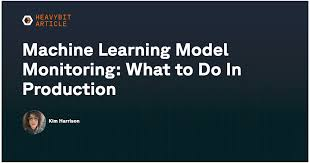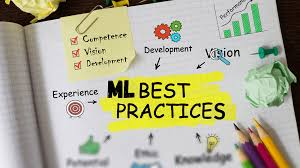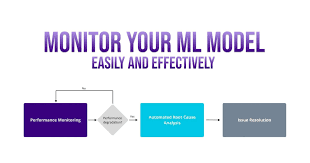ML Production Monitoring: A Comprehensive Guide to Reliable Systems 2024

Machine learning (ML) systems are increasingly powering critical applications, from fraud detection to autonomous driving. However, deploying models in production is only half the battle—ensuring they continue to perform as expected in dynamic environments is the real challenge. ML production monitoring is the process of continuously tracking model performance, data integrity, and system behavior to prevent failures and maintain reliability.
This blog delves into the importance of ML monitoring, the unique challenges it presents, and best practices to ensure system observability.
What is ML Production Monitoring?
ML production monitoring involves tracking, analyzing, and managing the performance of machine learning models and their supporting infrastructure in real-time. It ensures that:
- Models continue to perform as intended.
- Data pipelines remain robust.
- Infrastructure meets operational demands.
Key Components of ML Monitoring
- Model Performance Monitoring:
- Tracks metrics like accuracy, precision, recall, and F1-score.
- Identifies issues like prediction drift or declining accuracy.
- Data Monitoring:
- Ensures input data matches the quality and distribution of training data.
- Detects data drift and concept drift:
- Data Drift: Input distribution changes over time.
- Concept Drift: The relationship between inputs and outputs changes.
- Infrastructure Monitoring:
- Observes CPU/GPU usage, memory consumption, and latency.
- Ensures servers can handle model inference at scale.
- Business Metric Tracking:
- Connects model outcomes to key business metrics (e.g., revenue, conversion rates).
- Example: Monitoring click-through rates (CTR) for a recommendation system.
Unique Challenges in ML Monitoring
1. Dynamic Environments
- Real-world data is constantly evolving, which can lead to train-serving skew.
- Example:
- A stock prediction model trained on pre-pandemic data may fail with post-pandemic patterns.
2. Lack of Ground Truth
- In many cases, true labels aren’t available in real time, making it hard to assess performance.
- Solution:
- Use inferred metrics or delayed feedback loops for approximate monitoring.
3. Feedback Loops
- Model outputs can influence future inputs, potentially reinforcing biases.
- Example:
- A loan approval model may disproportionately reject applicants from certain demographics, skewing future training data.
4. Scaling Issues
- Monitoring hundreds or thousands of deployed models introduces complexity.
- Solution:
- Use centralized monitoring systems that can scale with workloads.
Key Metrics to Monitor

- Model Metrics:
- Accuracy: Percentage of correct predictions.
- Precision and Recall: Metrics for imbalanced datasets.
- Prediction Drift: Distribution of predicted classes over time.
- Data Metrics:
- Missing Values: Detect incomplete or corrupted inputs.
- Distribution Differences: Compare real-time inputs to training data distributions.
- Operational Metrics:
- Latency: Time taken for inference.
- Throughput: Number of predictions processed per second.
- Business Metrics:
- Revenue impact, customer retention rates, or fraud detection rates.
Best Practices for ML Monitoring

- Automate Monitoring Pipelines:
- Set up automated workflows to log and analyze model predictions and metrics continuously.
- Use Baseline Models:
- Compare current model predictions to simpler baseline models for anomaly detection.
- Integrate Alerts and Notifications:
- Define thresholds for metrics (e.g., accuracy < 80%) and notify stakeholders when breached.
- Simulate Real-World Scenarios:
- Use shadow deployments or A/B testing to observe model performance under real-world conditions before full rollout.
- Perform Root Cause Analysis:
- When issues arise, trace back through data pipelines, model code, and infrastructure to identify the source.
Advanced Techniques for ML Monitoring

1. Data Drift Detection
- Use statistical tests like KL divergence or chi-square tests to compare distributions.
- Implement real-time monitoring tools to detect shifts immediately.
2. Explainable AI (XAI) Monitoring
- Integrate tools like SHAP or LIME to understand model predictions and detect bias.
3. Canary Deployments
- Deploy models to a small subset of users to validate performance before full-scale rollout.
4. Continuous Retraining
- Implement CI/CD pipelines that retrain models automatically as new data arrives.
- Example: Weekly retraining for recommendation systems based on recent user behavior.
Tools for ML Production Monitoring
- Prometheus and Grafana:
- Popular tools for system monitoring, extended to track ML metrics.
- Evidently AI:
- Monitors data drift and prediction drift with visualizations.
- MLflow:
- Tracks experiments and integrates model monitoring features.
- Neptune.ai:
- Logs and visualizes model performance in production.
- Amazon SageMaker Monitor:
- Monitors deployed models on AWS for drift and latency.
Real-World Applications of ML Monitoring
1. E-Commerce
- Use Case: Monitoring recommendation engines.
- Metric: Click-through rate (CTR) and conversion rates.
2. Finance
- Use Case: Fraud detection systems.
- Metric: False positive and false negative rates for flagged transactions.
3. Healthcare
- Use Case: Monitoring disease prediction models.
- Metric: Accuracy and recall on newly collected patient data.
Future Trends in ML Monitoring
- AI-Driven Observability:
- Automating anomaly detection and root cause analysis using AI.
- Edge Monitoring:
- Observability for models deployed on edge devices with limited connectivity.
- Integrated MLOps Platforms:
- Unified solutions combining monitoring, CI/CD, and retraining pipelines.
- Ethical Monitoring:
- Tools to ensure fairness, transparency, and compliance with regulations like GDPR.
Conclusion
Effective monitoring transforms ML systems from experimental prototypes into reliable production assets. By proactively addressing challenges like data drift and feedback loops, organizations can ensure that their models deliver consistent performance and value. With the right tools and best practices, ML monitoring becomes a strategic enabler of robust, scalable machine learning.
Ready to monitor your ML models effectively? Start building your observability pipeline today!